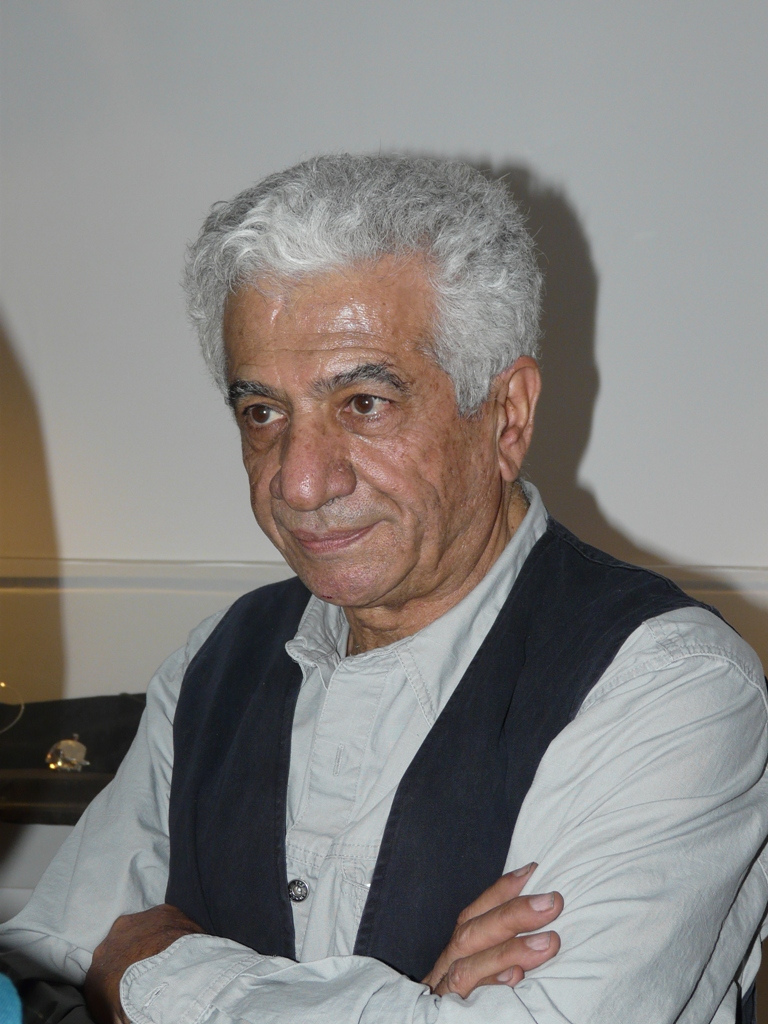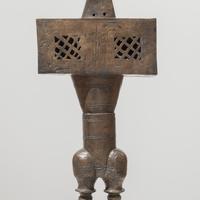More about Parviz Tanavoli
Works by Parviz Tanavoli

Contributor
Parviz Tanavoli is part of the Persian Saqqa-Khaneh school of art, and he often draws his influences from folk traditions of Iran, including pre-Islamic indigenous ones.
Critics say he's the most famous living Persian artist which, as you'll see, is not an easy title to hold.
As a young man, his parents sent him to Italy to study sculpture at the Accademia di Belle Arti di Carrara. When he ran out of money, he went back home to Tehran which, although a decision made from economic necessity, gave him some good opportunities to develop his work. These days of monarchy were relatively friendly to artists, compared to the Shīʿā regime that triumphed in the revolution of 1979, which views art the way most people view rodents in their kitchens. The government's minister of culture, Mehrdad Pahlbod, noticed Tanavoli's genius and arranged for him to study sculpture at Milan's Accademia di Belle Arti di Brera. It turns out that this government minister and his wife, Shams Pahlavi, the sister of the last Shah of Iran, had secretly converted to Catholicism a couple of decades earlier and so they fled to the Persian community in Los Angeles in 1979.
The 2,000-year-old Shami statue and other ancient sculptures are part of Iran's culture, but Tanavoli became the first sculptor in several centuries to give shows in his country. Who doesn't like a throwback, right? What could go wrong...right? Well, after 1979, the road got bumpy for Tanavoli, partly because he had gained so much fame and success for his masterpieces in the Heech ("Nothing") series. The series adheres to the government's official attitude toward art, which is that it must avoid shirk, the Quranic name for idolatry, by restricting itself, ideally, to Arabic or Persian calligraphy or geometry. Working within this strict format, Tanavoli realized that the Persian word for "nothing," هیچ چی, is a great point of departure for a series of sculptures. The concept itself is deep and universal, from Sufism, to Zen, to the Hebrew concept of Ein-Sof Barchu, "infinite sacred emptiness," even extending to the theory of the big bang and the singularity. He puts heech in a chair, puts heech to sleep, heech next to a wall. “My nothingness...was not tinged with the cynicism of Western artists,” he says. “Mine was the nothingness of hope and friendship, a nothingness that did not seek to negate. In my mind, it was not life that amounted to nothing, but rather nothing which brimmed with life itself.”
Tragically, as of this writing in 2020, these great heech works are still forcing Tanavoli to defend himself from charges of "nonsense," "skepticism," and "disturbing public opinion" from both the government and the government-controlled media. "Disturbing public opinion" is an odd phrase, making it sound as if "public opinion" is the habitat of an endangered species of marmot or eagle that Tanavoli had trampled through. At the same time, oddly enough, his house in Tehran is a proud symbol of his culture as it was designed in 1967 by the architect Kamran Diba – a cousin of the Queen – who went on to design the Tehran Museum of Contemporary Art. The government would love to love him, if only it could control him and his entire catalogue.
In the U.S., artists like Steven Paul Judd and Joy Harjo have not yet received their due recognition because their works present an indigenous viewpoint. Likewise, one of the reasons for Tanavoli's reputational challenges in his native country is his refusal to ignore pre-Islamic history: he fearlessly reminds people, for example, that the figure of the lion in Persian culture is much older than Islam. In 2016, the government prevented him from leaving the country for, the artist suspects, the publication of his book European Women in Persian Houses featuring a painting of a bare-breasted woman on the cover. He says that the government crackdown is specifically targeting Saqqa-Khaneh artists like himself, and that the ban prevented him from traveling to Canada to receive a scheduled surgery.
"Every time I go to leave Iran," he tells the Vancouver Sun, "my heart stops beating. I never know if I will be allowed to leave because it’s always at the last moment that people are detained. I keep going back because I didn’t do anything wrong.” Nothing wrong, indeed.
Sources
- "معرفی اثری از پرویز تناولی" Niavaran Cultural/Historic Complex, http://www.niavaranmu.ir/detail/718
- Aghazadeh, Shamim. "Parviz Tanavoli House, a masterpiece of Iranian architecture and decoration." Chidaneh, Oct. 6, 2015, https://www.chidaneh.com/blog/post/33656.
- Bramham, Daphne. "Daphne Bramham: Celebrated Iranian-Canadian sculptor skips New York show, can't risk U.S. travel ban." Vancouver Sun, Feb. 16, 2017, https://vancouversun.com/opinion/columnists/daphne-bramham-celebrated-i…
- Kermani, Hossein. "Details of Municipal Recordings of Parviz Tanavoli's Works, Exclusive Interview." Deutsche Welle Farsi, Mar 18, 2014, https://m.dw.com/fa-ir/جزئیات-ضبط-آثار-پرویز-تناولی-توسط-شهرداری-گفتوگو….
- "Parviz Tanavoli banned from publishing lies and disturbing public opinion." Iranian Labor News Agency, https://www.ilna.news/بخش-فرهنگ-هنر-6/388815-پرویز-تناولی-برای-نشر-اکاذ….
- Rahavard, Issues 13-14. Beverly Hills, CA: Society of the Friends of the Persian Culture, 1987.
- Schimmel, Annemarie. Calligraphy and Islamic Culture. New York: New York University Press, 1984.
- "Tanavoli: I was banned from leaving due to disturbing public opinion and spreading lies." BBC, Jul. 20, 2016, https://www.bbc.com/persian/iran/2016/07/160710_nm_tanavoli_artist_pass….
Featured Content
Here is what Wikipedia says about Parviz Tanavoli
Parviz Tanavoli (Persian: پرویز تناولی; born 1937) is an Iranian sculptor, painter, educator, and art historian. He is a pioneer within the Saqqakhaneh movement, a neo-traditionalist art movement. Tanavoli has been one of the most expensive Iranian artists in sales. Tanavoli series of sculpture work Heech are displayed in the British Museum, the Metropolitan Museum of Art, at Hamline University, in the Aga Khan Museum, and as public art in Vancouver. Tanavoli has also written extensively on this history of Persian art and craftsmanship. Since 1989, Tanavoli has held dual citizenship in Iran and Canada, and has lived and worked in both Tehran, Iran and Horseshoe Bay, West Vancouver, British Columbia.
Check out the full Wikipedia article about Parviz Tanavoli











